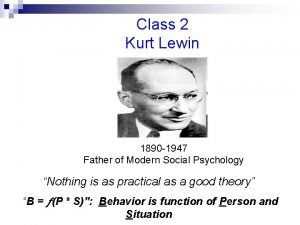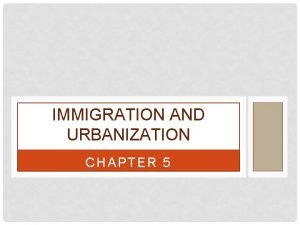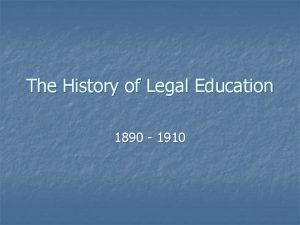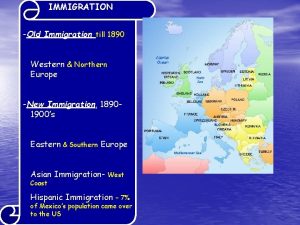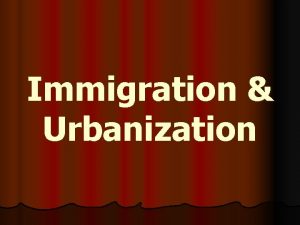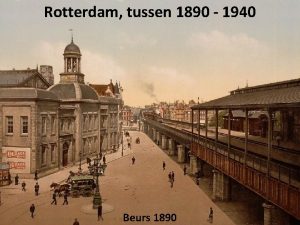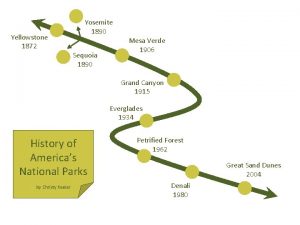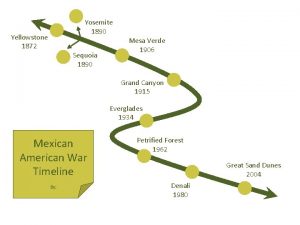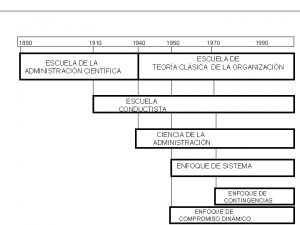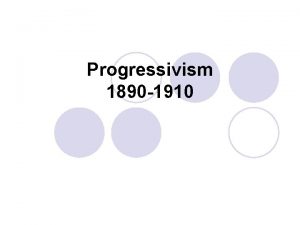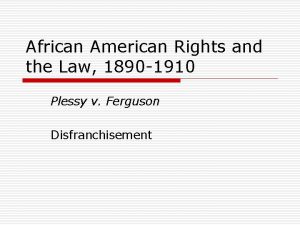US IMMIGRATION 1890 1910 What is immigration To




















- Slides: 20

US IMMIGRATION 1890 -1910

What is immigration? To enter and settle in a country or region to which one is not native. To send or introduce as immigrants: Britain immigrated many colonists to the New World.

1892 Ellis Island

Peak Immigration reached its historical peak in the Gilded Age and Progressive Era when almost 12 million immigrants entered the U. S. between 1890 and 1910.

Motivations for Immigration: Push (need to leave in order to survive) Pull factors (attracted to new way of life)

Reasons for Immigration 1607 -1830 Political Freedom (pull and push) Religious intolerance in home country (push) Economic Opportunity - People want a better life - better jobs - more money in US (pull) Political Refugees fear for their lives (push) Some want free social atmosphere (pull) Forced Emigration (Slavery) Family Reunification

Reasons for Immigration 1830 -1890 The main reason for immigration in the period from 1830 -1890 is Land. It remained plentiful, and fairly cheap. Jobs were abundant, and labor was scarce and relatively expensive. A decline in the birthrate as well as an increase in industry and urbanization reinforced this situation.

Reasons for Immigration 1890 -1924 Jews came for religious freedom Italians and Asians came for Work Russians came to escape persecution America had jobs America had religious freedom America was described in many countries as the "Land of Opportunity. "

DISILLUSION “I came to America because I heard the streets were paved with gold. When I got here, I found out three things: First, the streets weren’t paved with gold; second, they weren’t paved at all: and third, I was expected to pave them. ”

WHERE DID THEY COME FROM? Greece Hungary Italy Poland Russia China Japan Ireland Germany


“All of us (immigrants) clustered on the foredeck and looked with wonder on this miraculous land of our dreams. ”

How did they enter? Immigrants entering through the east coast would enter through Ellis Island, in New York Harbor. Immigrants entering on the West Coast gained admission at Angel Island, in San Francisco Bay. Immigrants endured harsh questioning and physical examinations. At Angel Island, immigrants were often subjected to long detention periods while awaiting entrance into the United States.

People who could not meet guidelines, had contagious diseases or mental disorders, had criminal records or no means to support themselves were deported.

Immigration Restriction Many native-born Americans thought of the United States as a melting pot, a mixture of people of different cultures and races who blended together by abandoning their native languages and customs. Many immigrants did not want to give up their native customs, causing anti-immigrant feelings. Anti-Immigrant groups began springing up, which led to nativism, or favoritism toward native-born Americans.

Why did Native-born Americans view immigrants as a threat? • Unable to fit into society • Caused social problems; crime, poverty, violence. • Cheap labor robbed Americans of jobs

Chinese Exclusion In California, Chinese immigrants were unable to own property or work at certain jobs.

1882 – CHINESE EXCLUSION ACT Denied citizenship and prohibited immigration of Chinese workers

IMMIGRATION RESTRICTION LEAGUE Wanted a literacy test for all immigrants. Passed by Congress, but vetoed by President Cleveland. He called it “Illiberal, narrow, and un-American”

 Reasons why rizal lived in london
Reasons why rizal lived in london Father of social psychology
Father of social psychology Ayon sa kaligirang pangkasaysayan
Ayon sa kaligirang pangkasaysayan Albertine et dukkehjem
Albertine et dukkehjem Old imperialism vs new imperialism chart
Old imperialism vs new imperialism chart Layunin ni jose rizal sa noli me tangere
Layunin ni jose rizal sa noli me tangere Marshall keynes
Marshall keynes 1890'lı yıllarda ingiltere'de whiff
1890'lı yıllarda ingiltere'de whiff 1890 computer
1890 computer Kirjanik 1886-1971
Kirjanik 1886-1971 Halimbawa ng biswal na komunikasyon
Halimbawa ng biswal na komunikasyon The population of smallville in the year 1890 was 6250
The population of smallville in the year 1890 was 6250 Guided reading activity settling the west 1865-1890 answers
Guided reading activity settling the west 1865-1890 answers Lissauer 1890
Lissauer 1890 Born 1890
Born 1890 The population of smallville in the year 1890 was 6250
The population of smallville in the year 1890 was 6250 Chapter 5 immigration and urbanization
Chapter 5 immigration and urbanization Jennie ellis australia immigration
Jennie ellis australia immigration European immigration to texas
European immigration to texas Immigration definition ap human geography
Immigration definition ap human geography Industrialization causes
Industrialization causes

